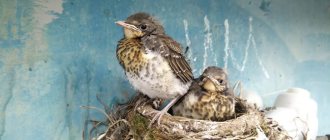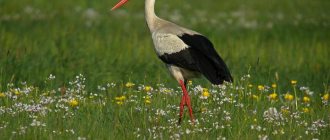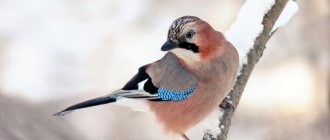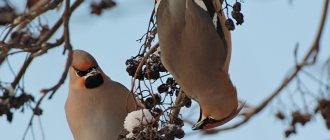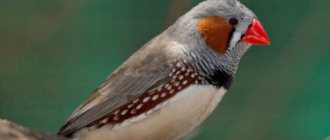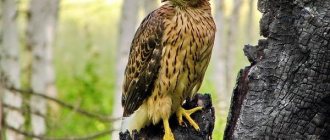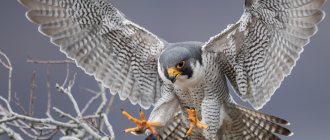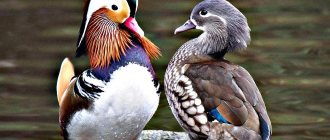- Wild animals
- >>
- Birds
Swifts live in small groups. There are about 100 species, usually grouped into two subfamilies and four tribes. This is the fastest bird in the world, characterized by its dependence on weather conditions. Swift is created for air and freedom. They are found on all continents, with the exception of Antarctica and distant islands, where they have not yet been able to reach. In European folklore, swifts were known as "Devil's Birds" - probably because they are inaccessible and, like owls, they attract more attention.
Origin of the species and description
Photo: Swift
The swift is medium in size, similar in appearance to a swallow, but a little larger. The similarities between these groups are due to convergent evolution, reflecting similar life styles based on catching insects in flight. However, their paths diverged in the distant past. Their closest relatives are New World hummingbirds. The ancients considered them a swallow without legs. The scientific name Apus comes from the ancient Greek α - “without” and πούς - “leg”. The tradition of depicting swifts without legs continued into the Middle Ages, as can be seen from heraldic depictions.
Fun Fact: Swift taxonomy is complex, with genus and species boundaries often disputed. Analysis of behavior and vocalizations is complicated by overall parallel evolution, while analysis of various morphological characters and DNA sequences has yielded ambiguous and partially contradictory results.
The common swift was one of the species described by the Swedish naturalist Carl Linnaeus in 1758 in the tenth edition of his work Systema Naturae. He introduced the binomial name Hirundo apus. The current genus Apus was formed by the Italian naturalist Giovanni Antonio Scopoli in 1777. The predecessor of the Central European subspecies, which lived during the last Ice Age, was described as Apus palapus.
Swifts have very short legs, which are used primarily for grasping vertical surfaces. They never voluntarily land on the ground where they might be in a vulnerable position. During non-breeding periods, some individuals can spend up to ten months in continuous flight.
Content
Swifts brought home should never be placed in bird cages. In them they will panic and fight, which will damage the plumage, without which it is impossible to fly. It is best to keep the swift in a plastic, half-open box. For a chick, the dimensions 30x20x15 cm (length, width, height) are quite suitable. A small “nest” made of cork or wood is also placed here. If these materials are not available, then a small glass vase wrapped in fabric to create warmth will do.
It is important that the box is clean. The swiftlets will be exercising their wings and therefore should not be exposed to droppings. Place absorbent paper towels in the bottom of the box and change them every day.
Appearance and features
Photo: Swift in flight
Swifts have a length of 16 to 17 cm and a wingspan of 42 to 48 cm, depending on the age of the specimen. They are black and brown except for the chin and throat, which can be white to cream in color. In addition, the upper part of the flight feathers is pale brown-black compared to the rest of the body. Swifts can also be identified by their moderately forked tail feathers, narrow sickle-shaped wings, and their high-pitched calling sounds. They are often mistaken for swallows. The swift is larger, has a completely different wing shape and flight diagonal than the swallows.
All species in the family Apodidae (swifts) have unique morphological characteristics, a lateral "grasping foot" in which toes one and two oppose toes three and four. This allows regular clippers to attach to areas such as stone walls, chimneys and other vertical surfaces that are inaccessible to other birds. Males and females look the same.
Video: Swift
Individuals show no seasonal or geographic changes. However, it is possible to distinguish juveniles from adults by slight differences in color intensity and uniformity, as juveniles are usually blacker in color, have white-fringed forehead feathers, and a white patch under the beak. These differences are best observed at close range. They have a short forked tail and very long drooping wings that resemble a crescent moon.
Swifts produce a loud call in two different tones, the highest of which comes from the females. They often form "screaming parties" on summer evenings when 10-20 individuals gather in flight around their nesting site. Large screaming groups form at high altitudes, especially at the end of the breeding season. The purpose of these parties is unclear.
Interesting fact
People see swifts almost every day. But due to their discreet color, it is unlikely that anyone will remember such a last meeting. When in a hurry, a swift may generally seem similar to a young pigeon, which is why people think that it is not a swift.
Swifts are the birds that are the first to sense the arrival of spring and begin to scream under the windows. The voice, by the way, is very loud and disgusting to people. It is difficult to confuse it with other birds. This is due to the strong dependence of swifts on the weather; they sense a change in the weather in advance and begin to prepare for it.
Usually, swifts build their nests for many years, and after a winter in foreign lands, they return to their old place. One can endlessly marvel at the memory of these birds, but if they survive the winter well, they will definitely return to their native nest. They build their house in old trees or in small cracks under the roof of a human dwelling.
- The speed of swifts can reach 170 km/h.
- In flight, the swift is able to sleep for several hours at a time, only occasionally flapping its wings.
- Their body's thermoregulation is poorly developed, so when there is a sharp cold snap, the swift goes into hibernation.
- The only enemy of swifts is the falcon, only it develops the necessary speed for hunting.
- In one day, a female and a male can bring up to 4,000 insects to their young.
- If there is not enough food to feed the offspring, then the parents are able to throw the eggs out of the nest.
Where does the swift live?
Photo: Swift bird
Swifts live on all continents except Antarctica, but not in the far north, large deserts or oceanic islands. Common swifts (Apus apus) can be found in almost every region from Western Europe to East Asia and from northern Scandinavia and Siberia to North Africa, the Himalayas and central China. They live throughout this range during the breeding season and then migrate for the winter months to southern Africa, from Zaire and Tanzania south to Zimbabwe and Mozambique. The summer distribution range extends from Portugal and Ireland in the west to China and Siberia in the east.
They breed in countries such as:
- Portugal;
- Spain;
- Ireland;
- England;
- Morocco;
- Algeria;
- Israel;
- Lebanon;
- Belgium;
- Georgia;
- Syria;
- Türkiye;
- Russia;
- Norway;
- Armenia;
- Finland;
- Ukraine;
- France;
- Germany and other European countries.
Common swifts do not breed on the Indian subcontinent. Most nesting habitat is located in temperate zones where there are suitable trees for nesting and sufficient open space in which to gather food. However, the habitat of swifts becomes tropical for several months after migrating to Africa. These birds prefer areas with trees or buildings with open spaces, as they are able to use vertical surfaces such as stone walls and pipes due to a unique physical adaptation.
Making mixtures
If you have had a black swift for several days now, what should you feed it to keep your feathered pet healthy and active? As mentioned above, you can’t do without insects here. However, in addition to this, additional minerals and vitamins must be present in the diet. In order to enrich food with elements necessary for the health of the swift, special mixtures should be prepared. Recipes for some of them are given below:
- The mixture for the swift includes finely grated boiled chicken eggs, lean beef, and mealworms, chopped with scissors. Ant pupae are also added here. Instead of mealworms, the mixture can be enriched with insects caught in nature, fresh bloodworms or pre-scalded maggots.
- This recipe has a wide variety of products, so it is especially good for keeping swifts for a long time. In this case, the mixture includes 20% raw lean ground beef, 25% hard-boiled chicken egg, pre-grated, 20% non-acidic, preferably boiled and squeezed cottage cheese, 20% ant pupae or mealworms, 10% finely grated carrots and 5 % baby formula.
- Another mixture rich in vitamins and minerals includes 30% minced beef heart, 25% chopped hard-boiled chicken eggs, 15% cottage cheese, 15% grated carrots, 10% insects and 5% baby formula.
- For black swift chicks aged 3-6 weeks, the mixture includes: 2-3 house crickets, 3-4 drones, half a wax moth larva, several flies and their larvae, and one-eighth of a teaspoon of crushed dried insects.
The prepared products are rolled into balls the size of peas, and 4-5 pieces are given per feeding. It is also important not to forget to water your feathered pet. This should be done after each feeding, dropping 4-5 drops of water into the beak from a pipette. You can go another way. Drinking may not be given at all if the balls are pre-moistened in water before feeding.
What does a swift eat?
Photo: Swift
Common swifts are insectivorous birds and feed exclusively on aerial insects and spiders, which they capture with their beaks during flight. The insects are gathered together in the throat with the help of a product from the salivary glands to form a food ball or bolus. Swifts are attracted to swarms of insects as they help them quickly collect enough food. It is estimated that there are an average of 300 insects per bolus. These numbers may vary depending on the abundance and size of prey.
The most commonly consumed insects:
- aphid;
- wasps;
- bees;
- ants;
- beetles;
- spiders;
- flies.
Birds fly with their beaks open, catching prey using quick maneuvers or simply flying quickly. One type of swift can reach a speed of 320 km/h. They often fly near the surface of the water to catch insects flying there. While collecting food for newly hatched chicks, adults deposit beetles in their elastic throat pouch. After the bag is filled, the swift returns to the nest and feeds the young. Young nesting swifts are able to survive for several days without food by lowering their body temperature and metabolic rate.
Interesting fact: Except for the nesting period, swifts spend most of their lives in the air, living on energy obtained from insects caught in flight. They drink, eat, sleep on the wing.
Some individuals fly for 10 months without landing. No other bird spends so much of its life in flight. Their maximum horizontal flight speed is 111.6 km/h. Over the course of their lives, they can cover millions of kilometers.
Arrival after wintering
Scientists have discovered many interesting ecological features of swifts. One of them is that after wintering, these birds arrive quite late. However, their appearance guarantees the onset of stable heat.
Swifts fly to their native nests within a certain period, lasting from 18 to 27 days. Moreover, these birds do not create a large school. They appear in small groups. Arrival times vary by one or two days.
Features of character and lifestyle
Photo: Black Swift
Swifts are a very sociable bird species. They typically nest, live, migrate and hunt for food in groups throughout the year. Additionally, these birds are unique in their ability to remain aloft for long periods of time. They often spend the entire day on the wing, only landing to feed young chicks or roost at night. Common swifts are estimated to fly at least 560 km per day during the nesting season, demonstrating their stamina and strength, as well as their incredible aerial abilities.
Swifts can also mate and forage for food while in the air. Birds prefer to fly in lower airspace when the weather is bad (cold, windy and/or high humidity), and move to higher airspace when the weather is favorable for prolonged aerial activity.
Interesting fact: In August and September, swifts leave Europe and begin their journey to Africa. Sharp claws are extremely useful during this flight. Although the chicks hatch before migration begins, observations indicate that many young individuals do not survive the long journey.
Swifts can nest in former woodpecker cavities found in forests, for example about 600 nesting birds in Belovezhskaya Pushcha. In addition, swifts have adapted to nesting in artificial areas. They build their nests from airborne material captured in flight and combined with their saliva, in the cavities of buildings, in gaps under window sills and under eaves and inside gables.
Geography of distribution
Swifts can be found throughout Europe with the exception of tundra zones. These birds also flew beyond the Urals, populating territories as far as Transbaikalia. Small black birds also live in North-West Africa. You can meet them in Syria and Palestine, as well as in the Himalayas.
Swifts winter in Africa. During this period, they occupy all of its southern territories, starting from the equator, reaching the island of Madagascar.
Today, the swift is considered a city bird. However, some of its nesting sites are also found in rural areas. In villages, birds choose stone buildings for their settlements. They can be cowsheds and churches, as well as grain warehouses.
But in Transbaikalia, the black swift can only be found in forest areas. Its brother nests in cities. This is another species of swift called the white-banded swift.
Social structure and reproduction
Photo: Swift chick
Swifts begin breeding at the age of two and form pairs that can mate for years and return to the same nest and partner year after year. Age at first breeding may vary depending on the availability of nesting sites. The nest consists of grass, leaves, hay, straw and flower petals. Swift colonies contain 30 to 40 nests, reflecting the birds' sociable nature.
Common swifts breed from late April to early May until mid-September when the young fledge. One of the bird's most unique characteristics is its ability to mate in flight, although they can also mate in the nest. Mating occurs every few days after suitable weather arrives. After successful copulation, the female lays one to four white eggs, but the most common clutch size is two eggs. Incubation lasts for 19-20 days. Both parents participate in incubation. After hatching, it may take another 27 to 45 days before the young fledge.
During the first week after hatching, the clutch is heated all day long. During the second week, the parents warm the chicks for about half the day. The rest of the time, they rarely heat the masonry during the day, but almost always cover it at night. Both parents are equally involved in all aspects of raising the chicks.
Interesting Fact: In the event that bad weather persists for a long time or food sources become scarce, the hatchlings have the ability to become semi-torpid, as if going into hibernation, thus reducing the energy requirements of their rapidly growing bodies. This helps them survive on little food for 10-15 days.
The chicks are fed food pellets, consisting of insects collected by the parents during flight and held together by the salivary gland, creating a food bolus. Small chicks share the food bolus among themselves, but as they grow larger, they can swallow an entire food bolus on their own.
Feeding on insects
What to feed a swift in captivity so as not to harm it? House and banana crickets are ideal for this purpose. You can purchase these insects at pet stores for a small fee. However, they are not the only ones your swift can consume. What to feed your new pet at home? Its menu is varied with Turkmen and marbled cockroaches. These insects contain a large amount of useful substances. If you don’t know what to feed the swift chick, then buy these cockroaches for it. They will not only be perfectly absorbed by the young individual, but will also have a positive effect on the quality of its plumage.
For the health of swifts, it is useful to feed them ant pupae. This bird food contains a wide variety of vitamins. Where can I get ant pupae? They can be found in the garden or in the forest. A swift will eat this delicacy with pleasure.
What else can you feed this bird at home? Flies and mosquitoes will be a good help for her.
Often people caring for a feathered pet ask the question: “Can I feed a swift with bloodworms?” Yes, inclusion of these insects in the menu is allowed. However, it is worth remembering that the bloodworms should only be fresh.
The question also often arises about whether it is possible to feed a swift with maggots. Yes, they come as an addition to the main diet. Only maggots should be washed and finely chopped. It is worth remembering that this food is fatty and creates unnecessary stress on the bird’s liver. That is why maggots can be given to swifts in minimal quantities. This volume should not exceed one teaspoon per day.
What to feed an adult swift? For feeding, you can add mealworms grown using pure raw materials to its menu. During the day, their number should not exceed 3 pieces. However, it is worth remembering that such worms should be pressed down a little before serving. This is due to the fact that the larvae of these beetles have very strong jaws that can damage the bird’s esophagus. Also, in order not to harm the swift, the heads of the mealworms can simply be cut off.
Earthworms are a dangerous food for swifts. Birds can pick up helminths from them.
Natural enemies of swifts
Photo: Swift in the sky
Adult black swifts have few natural enemies due to their extreme flight speeds. There are few documented cases of attacks on these birds. Strategic placement of nests helps swifts prevent attacks from land-based predators. Placing nests in depressions provides cover on top, and when combined with dark skin and downy feathers camouflaging the chicks on top, provides protection from aerial attack. In some cases, easily visible nests have been damaged by humans.
The swifts' unique protective adaptations, developed over centuries, allow the birds to avoid most of their natural predators, including:
- Hobby (Falco Subbuteo);
- hawk (Accipiter);
- common buzzard (Buteo buteo).
Selecting nesting sites on vertical surfaces such as stone walls and chimneys also makes common swifts difficult to hunt due to the difficulty of accessing the nest area. The simple coloring also helps avoid predators, as they are difficult to see when they are not in the air. The vast majority of attacks on swifts involve their eggs, collected by humans until the 21st century.
The black swift is more susceptible to mortality due to harsh environmental conditions. Typical nest placement in damp areas creates potential danger for the chicks. If the baby falls out of the nest prematurely or flies out before it can sustain a long flight, or they may be washed away or their feathers become weighed down by moisture. Nests can be lost due to flash floods.
Help for birds
It happens that a bird that has received any damage ends up right under a person’s feet. Anyone who decides to help her and take the little warm lump home must, first of all, determine whether the bird is an adult or not. Swift chicks are distinguished by a white edging located on the large flight feathers, as well as white specks on the head and the presence of tubes from which the feathers open.
After this, the person should examine the bird for any deviations from the norm and external disturbances. To do this, all parts of the body are carefully studied. If the wing or leg of a swift is dangling, then the bird should be taken to a specialist, since this condition indicates the presence of a fracture.
In the absence of external damage, lethargic and weakened birds must be checked for the presence of infectious diseases. In this case, you will need to be tested for psittacosis, bird flu, helminths and protozoa.
Sedentary swifts must be warmed up. For this, incandescent lamps with a power of 40 or 60 W are suitable, as well as bottles and hot water bottles.
A person should also check whether the swift they find has a swallowing reflex. What to feed this bird at home? Her diet does not have to be varied. In the process of nursing and feeding a swift, you need to remember what the bird eats in natural conditions and not deviate from its natural diet.
Why is the bird constantly in flight?
Swifts spend most of their lives flying, since on the ground they can become a victim of a predator at any time. But this is not the only reason why they spend all their time in the sky.
The characteristic uniqueness of the bird is that it practically cannot walk. This is due to the structure of the paws. They have only 4 fingers facing to the side. Therefore, it is very difficult for her to maintain balance on the ground. She also cannot jump or walk on her legs.
A swift can stay in the sky for 3-4 years: there it eats, sleeps and mates. By nature, birds are very nimble, as they reach speeds of up to 120 km/h in flight, which is twice the speed of a swallow. They even make nests at high altitudes: in tree hollows or rocky coastal cliffs.
During the time that ornithologists have been observing these special birds, several interesting facts about them have been revealed.
The black swift catches insects with its beak in flight. The structure of the jaw allows you to put up to 1000 insects into your mouth at a time.
Swift chicks eat a lot. During their growth, an adult individual brings about 40 thousand insects each. To deliver so much food, he has to make 30-40 search flights. In total, the distance over which the swift flies during the search reaches 40 thousand kilometers.
10 weeks after birth, the chicks are able to feed and fly independently. They rise up to a height of 2000 meters and remain there until they grow up. Swifts sleep only in flight, waking up every 10 seconds to flap their wings.
An unpleasant fact! In the late 19th century, people hunted swifts' eggs and nests because their meat was believed to have healing properties. Hunting has brought the birds to the brink of extinction.
Feeding technique
A strong and healthy swift chick feeds actively. It literally pounces on the person's hand holding the food. It is most convenient to give food to such birds using tweezers.
Weakened swiftlets, even if they are very hungry, do not open their beaks themselves. They are given food either from a finger or from a syringe. But first of all, the haircut is fixed like a shawarma using a napkin. Next, they open its beak with a fingernail, where food is placed. Such manipulations are successful. Even very weakened chicks begin to swallow insect mush with pleasure. After feeding, it is advisable to drop a few drops of water on the root of the bird's tongue. All described manipulations must be done carefully and gently. This is necessary in order not to bend or break the fragile tissues of the beak. Adult emaciated swifts are fed in the same way as chicks, giving them semi-liquid soft food from insects.
Answers to pages 20 - 22
1. Thawed patches Fill in the missing words. What words convey comfort and warmth? How does the author write about this? Emphasize.
The little haircut hatched from an egg in a dark hole and squeaked in surprise. Nothing was visible. Only a speck of light dimly flickered far, far away. The little haircut was frightened by this light and clung closer to the warm and soft mother-haircut. She pressed his wing to her. He dozed off, basking under the wing.
2. Search What rules did Skrip learn, what did he understand? What did his mother teach him? Find the answers and underline them.
And the mother-haircut gave the second drop not to him, but to another haircut. It's a shame. The short-haired little Skrip fell silent and became angry with his mother and brothers and sisters, who, it turned out, were also hungry. When mom brought the midge and gave it to another little one, Skrip tried to take it away. Then the mother-haircut hit Creak on the head with her beak so much that he lost all desire to take food from others. The little haircut realized how serious and strict their mother was. You can't pity her with a squeak.
3. Diagram How many enemies do little swifts have? Fill out the diagram.
Enemies of swifts: boys, falcon, crow, viper, kite.
4. Search How did Skrip live without his mother? Who helped the haircuts? Find and underline the answers.
But Skrip didn’t yet know how friendly the swifts are! At night, the leader, White Belly, dived towards them, tickled the chicks with his beak, hugged them with his wings, and they warmed up and fell asleep. And when it dawned, a neighbor’s shearer came to Skrip’s hole and brought a large mosquito. Then more swifts and swifts flew in and brought food and drops of water. And at night, the leader White Belly again flew to the orphaned shorthairs.
5. Scheme Who did Skrip have to communicate with? Fill out the diagram. Write down what feelings Skrip experienced while communicating with these characters.
6. Exact word Re-read the last episode of the story. What do swifts give people? What words contain sadness? Hope? Emphasize.
- Goodbye, Creak! Goodbye! Fly to your hole! - the fishermen shouted after Skrip. Swifts fly away overnight and take summer with them. They also arrive in one night and bring summer with them. It's boring without swifts on the river. Something is missing. Where are you, little Creak? In what regions and countries? Come back soon! Bring summer to us on your wings!
Answers to assignments. Literary reading. Workbook No. 2. 3rd grade. Efrosinina L. A.
V.P. Astafiev. Strizhonok Skrip 4.4 (88.71%) from 209 voters
Number of meals
How many times should you feed a swift at home? Small and weakened chicks are given food every hour throughout the day from six in the morning to ten in the evening. In this case, the food should be small portions of ground bugs. Strong and mature swifts feed less frequently, every two to three hours. It is important that the bird is fed sufficiently densely. To do this, she needs to completely fill her goiter. And this can be done only by giving the maximum amount of feed.
The crop in most birds is part of the esophagus. In this zone, food is accumulated and stored, which helps the swift not to be distracted from its hunt. They learn about the filling of the crop by feeling a small (pea-sized) ball on the bird’s neck. As a rule, a typical meal is equal to five cockroaches or ten medium-sized crickets.

